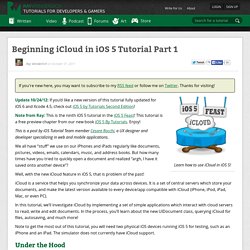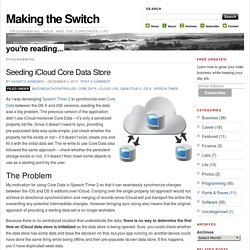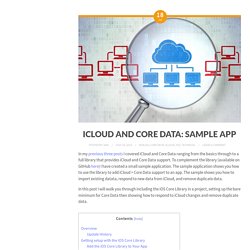

Ios - CoreData with iCloud: Receiving empty data on NSPersistentStoreDidImportUbiquitousContentChangesNotification. Beginning iCloud in iOS 5 Tutorial Part 1. If you're new here, you may want to subscribe to my RSS feed or follow me on Twitter.

Thanks for visiting! Learn how to use iCloud in iOS 5! Update 10/24/12: If you’d like a new version of this tutorial fully updated for iOS 6 and Xcode 4.5, check out iOS 5 by Tutorials Second Edition! Note from Ray: This is the ninth iOS 5 tutorial in the iOS 5 Feast! This tutorial is a free preview chapter from our new book iOS 5 By Tutorials. This is a post by iOS Tutorial Team member Cesare Rocchi, a UX designer and developer specializing in web and mobile applications. We all have “stuff” we use on our iPhones and iPads regularly like documents, pictures, videos, emails, calendars, music, and address books. Nsurlconnection - Easiest way to detect Internet connection on iOS? Mluisbrown/iCloudCoreDataStack. iCloud Complications, Part 2: De-duplication. Today I'm continuing my series of iCloud/Core Data-related posts with a discussion of duplicate data, how and why it occurs, and what you can do about it in your apps.

As with my previous post in this series, today I'm sticking to how things are supposed to work and sometimes actually do. The problem of duplicate data isn't actually specific to iCloud. It can happen in any case where people might create data on different devices and where your app wants to sync that data between the devices. Some sync solutions may try to solve the problem for you, but iCloud does not. Why are Duplicates Possible? In short: Core Data doesn't care if you create multiple objects with identical data fields. That's not completely true-- there's always a unique managed object ID, which keeps each instance unique. How Can Syncing Cause Duplicates? Seeding iCloud Core Data Store. As I was developing Speech Timer 2 to synchronize over Core Data between the OS X and iOS versions, seeding the data was a big problem.

The previous version of the application didn’t use iCloud moreover Core Data – it’s only a serialized property list file. Since it doesn’t need to sync, providing pre-populated data was quite simple: just check whether the property list file exists or not – if it doesn’t exist, create one and fill it with the initial data set. The re-write to use Core Data also followed the same approach – check whether the persistent storage exists or not; if it doesn’t then insert some objects to use as a starting point by the user. iCloud and Core Data: Sample App. In my previous three posts I covered iCloud and Core Data ranging from the basics through to a full library that provides iCloud and Core Data support.

To complement the library (available on GitHub here) I have created a small sample application. The sample application shows you how to use the library to add iCloud + Core Data support to an app. The sample shows you how to import existing datata, respond to new data from iCloud, and remove duplicate data. In this post I will walk you through including the iOS Core Library in a project, setting up the bare minimum for Core Data then showing how to respond to iCloud changes and remove duplicate data. The topic of Core Data, and in particular iCloud, is not a beginner level topic. Update History The full code for the iOS Core Library (and this example) is available on GitHub here. The library does include some code from third parties (Dropbox, Apple and Kevin Cassidy Jr.) iCloud Complications, Part 2: De-duplication. Bluetooth... Performing Common Central Role Tasks. Devices that implement the central role in Bluetooth low energy communication perform a number of common tasks—for example, discovering and connecting to available peripherals, and exploring and interacting with the data that peripherals have to offer.

In contrast, devices that implement the peripheral role also perform a number of common, but different, tasks—for example, publishing and advertising services, and responding to read, write, and subscription requests from connected centrals. In this chapter, you will learn how to use the Core Bluetooth framework to perform the most common types of Bluetooth low energy tasks from the central side. The code-based examples that follow will assist you in developing your app to implement the central role on your local device. Create a Cloud Backend for Mobile App using Parse. iOS 7 : background fetching pour tout le monde. Entre iOS et les applications qui veulent travailler en tâche de fond, c’est compliqué.

Le système a de bonnes raisons pour économiser les cycles de son processeur, tandis que les développeurs en veulent toujours plus. Bonne nouvelle, tout change avec iOS 7, le “background fetching” est maintenant ouvert à tous. Note : je ne sais pas trop comment traduire “background fetching”, le terme utilisé par Apple, en français. Le but, c’est de récupérer des données lorsque l’application tourne en tâche de fond. Ceci dit, vous n’êtes pas non plus limités au téléchargement, même si ce mode d’exécution a ses limites. Configuration du projet La mise en place du background fetching est très simple.
Il faut d’abord activer la capacité dans les réglages du projet. Concrètement, cette activation correspond à l’ajout d’une valeur dans le Info.plist de votre projet : <key>UIBackgroundModes</key><array><string>fetch</string></array> Mise en place de la fréquence d’utilisation. UsingCoreDataWithiCloudPG.pdf. Sign in with your Apple ID - Apple Developer. Using the SQLite Store with iCloud. About Incorporating iCloud into Your App. iCloud is a free service that lets users access their personal content on all their devices—wirelessly and automatically via Apple ID. iCloud does this by combining network-based storage with dedicated APIs, supported by full integration with the operating system.

Apple provides server infrastructure, backup, and user accounts, so you can focus on building great iCloud-enabled apps. The core idea behind iCloud is to eliminate explicit synchronization between devices. A user never needs to think about syncing, and your app never interacts directly with iCloud servers. When you adopt iCloud storage APIs as described in this document, changes appear automatically on all the devices attached to an iCloud account. Your users get safe, consistent, and transparent access to their personal content everywhere.
At a Glance iCloud is all about content, so your integration effort focuses on the model layer of your app. Create a Cloud Backend for Mobile App using Parse.